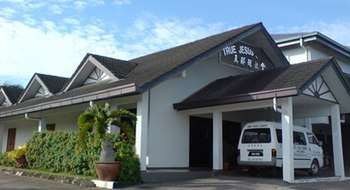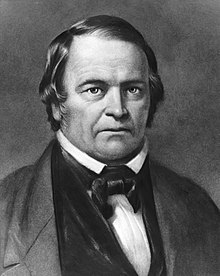True Jesus Church
The True Jesus Church is a Christian Church that originated in Beijing, China during the Pentecostal movement in the early twentieth century.[1] The TJC is currently one of the largest Christian groups in China and Taiwan,[2] as well as one of the largest independent churches in the world.[3]
| True Jesus Church | |||||||
|---|---|---|---|---|---|---|---|
| Traditional Chinese | 真耶穌教會 | ||||||
| Simplified Chinese | 真耶稣教会 | ||||||
| |||||||

History
The TJC emerged independently alongside other indigenous Christian groups of that period such as the Little Flock, the Jesus Family and The Christian Tabernacle.[4]
Established in 1917, the church’s early adherents in Hebei and Shandong[5] were influenced by certain charismatic practices of the Apostolic Faith Mission in China,[6] the Seventh-day Adventist Church, and the Pentecostal Assemblies of the World, especially faith healing, baptism of the Holy Spirit, footwashing, and Sabbath keeping.
The TJC was founded by Paul Wei (Wei Enbo, 1877-1919) in 1917.[7] A former member of the Beijing branch of the London Missionary Society led by British missionary Samuel Evans Meech (1845–1937), Wei became a Pentecostal under the influence of Norwegian missionary to China, Bernt Berntsen. In 1917, he left Berntsen’s group and claimed that a vision had directed him to found his own church. Wei predicted that the world will end in 1921 or 1922. He died of tuberculosis on September 10, 1919, and the failure of his prophecy did not prevent the further growth of the TJC.[8]
The TJC’s early leaders included Zhang Lingsheng (1863—?), who convinced Wei that the church should maintain a seventh-day Sabbath, and Barnabas Zhang (1882–1961), who eventually left the group in 1929 and established a rival movement in Hong Kong.[9]
In Mainland China, Wei’s son, Wei Wenxiang (魏文祥, Isaac Wei, 魏以撒, ca. 1900-?), emerged as the main leader of the TJC. He also presided over TJC’s international expansion to various countries and the establishment of an effective bureaucracy.[10]
By 1949, the membership grew to around 120,000 in seven hundred churches.[11] In 1951, Isaac Wei was arrested and “disappeared.” How and when he died is unknown. Li Zhengcheng (李正誠, ca.1920-1990) replaced Isaac Wei as the main leader of the TJC and lead it into joining the Three-Self Patriotic Movement as the government had requested. Scholar Melissa Inouye reports that, fearing persecution, the leaders mourned the death of Joseph Stalin in 1953 claiming that he was now in Heaven. One even stated that “Comrade Stalin has saved many tens of thousands of people, more than Jesus.” Persecution, however, came, both before and during the Cultural Revolution Li Zhengcheng spent more than twenty years in jail. Because of the developments in China, the TJC abroad proclaimed its autonomy, with headquarters first in Taiwan and from 1985 in the U.S. The Chinese branch was however reconstituted, as part of the Three-Self Church, after the Cultural Revolution and the reforms of Deng Xiaoping and still has a substantial following in China.[12]
Today there are officially 1.5 million members in fifty eight countries.[13]
Current organization
Mainland China
In mainland China most of the True Jesus Church congregations are members of the Three-Self Patriotic Movement, and usually meet on Saturdays in TSPM church buildings as separate sabbatarian sub-congregations.[14] However, since TJC practices such as healing and tongues are "frowned upon"[14] in the TSPM other congregations are independent Chinese house churches.[15]
Taiwan and the United States
Outside China member churches of the TJC look to the central synod of the TJC in California.[16] In 1967 TJC church leaders from outside mainland China met for the first World Delegates Conference in Taiwan, and an international headquarters was established in Taichung, Taiwan, where a seminary was opened. The headquarters was subsequently moved to California in 1985.[1]
United Kingdom
In the United Kingdom, True Jesus Church congregations were established as a result of immigration patterns in the 1960s and 1970s, coming largely from Malaysia and Hong Kong, the latter especially from Ap Chau.[17] This would result in a number of congregations being established throughout the country, particularly in Northern England and Scotland, such as Leicester, Newcastle, Sunderland, Elgin, Edinburgh and Cardiff.[17][18][19]
Beliefs
|
Practices
The church practices baptism via full body immersion for both adults and infants, with holy communion.[9] Speaking in tongues is practiced and usually occurs while in prayer.[1]
The church believes that the sacraments must fulfil three requirements according to the Scripture. Firstly, they must have been performed by Jesus Christ himself as an example. Secondly, the sacraments must be directly related to one's salvation, eternal life, entering the Heavenly Kingdom, and having a part with Jesus. Lastly, they must be of the sacraments which Jesus Christ instructed the disciples to perform as well. There are ten articles of faith[20] that the True Jesus Church holds in order to worship God correctly. According to them, one must speak in tongues as evidence of receiving the Holy Spirit. The mode of baptism also determines salvation. The correct mode should be with the head facing down (in the manner of Jesus' death) and only in natural ("living") water.
References
- Melton, J. Gordon (2005). "True Jesus Church". Encyclopedia of Protestantism. pp. 536–537. ISBN 978-0816069835.
- Eric Patterson, Edmund Rybarczyk (2007). The Future of Pentecostalism in the United States. p. 130. ISBN 978-0739155424.
- Allan Anderson (2013). An Introduction to Pentecostalism: Global Charismatic Christianity. p. 50. ISBN 978-1107033993.
- Peter Tze Ming Ng (2012). Chinese Christianity: An Interplay between Global and Local Perspectives. p. 205. ISBN 978-9004225756.
- Bays, Daniel H. (1999). Christianity in China: From the Eighteenth Century to the Present. Stanford, CA: Stanford University Press. p. 425. ISBN 978-0804736510.
- Gerald H. Anderson (1999). Biographical Dictionary of Christian Missions. p. 125. ISBN 978-0802846808.
- Lambert, Tony (2006). China's Christian Millions. Oxford. pp. 59–60. quoted in Refugee Review Tribunal
- Melissa Wei-Tsing Inouye, China and the True Jesus: Charisma and Organization in a Chinese Christian Church, New York: Oxford University Press, 2018, 86–118.
- Melton, J. Gordon; Baumann, Martin (2010). "True Jesus Church". Religions of the World: A Comprehensive Encyclopedia. p. 2894. ISBN 978-1598842043.
- Inouye (2018), 157–185.
- Jason Kindopp, Carol Lee Hamrin (2004). God and Caesar in China: Policy Implications of Church-state Tensions. p. 109. ISBN 978-0815796466.
- Inouye (2018), 187–259.
- True Jesus Church International Assembly. "A Chronology of the establishment of TJC in various countries". tjc.org. Retrieved June 1, 2014.
- Bays, Daniel H. (2003). "Chinese Protestant Christianity Today". In Overmyer, Daniel L. (ed.). Religion in China Today. Cambridge: Cambridge University Press. p. 189. ISBN 978-0521538237.
- Kupfer, Kristin (2013). "Saints, Secrets, and Salvation". In Lim, Francis Khek Gee (ed.). Christianity in Contemporary China Socio-cultural Perspectives. New York: Routledge. p. 186.
- Rubinstein, Murray A. (1991). The Protestant Community on Modern Taiwan. Armonk, NY: M.E. Sharpe. p. 129. ISBN 978-0873326582.
- "My Church - United Kingdom General Assembly 英國總會 / 英国总会". members.tjc.org. Retrieved 24 October 2016.
- Liu, Garland (1998). "The Role of the True Jesus Church in Communal Development of the Chinese People in Elgin, Scotland". In Sinn, Elizabeth (ed.). The Last Half Century of Chinese Overseas. Hong Kong: Hong Kong University Press. pp. 425–446. ISBN 978-962-209-446-8.
- Li Wei (1994). Three Generations, Two Languages, One Family: Language Choice and Language Shift in a Chinese Community in Britain. Multilingual Matters. p. 64. ISBN 978-1-85359-241-6.
- True Jesus Church International Assembly. "Statement of Faith". True Jesus Church. Archived from the original on June 2, 2014. Retrieved June 1, 2014.
Further reading
- Bays, Daniel H. (1995). "Indigenous Protestant Churches in China, 1900–1937: A Pentecostal Case Study". In Kaplan, Steven (ed.). Indigenous Responses to Western Christianity. New York: New York University Press. pp. 124–143. ISBN 978-0-8147-4649-3.
- Inouye, Melissa Wei-Tsing (2018). China and the True Jesus: Charisma and Organization in a Chinese Christian Church, New York: Oxford University Press. ISBN 978-0-19-092346-4.
- Lian Xi (2008). "A Messianic Deliverance for Post-Dynastic China: The Launch of the True Jesus Church in the Early Twentieth Century". Modern China. 34 (4): 407–441. doi:10.1177/0097700408318908.
